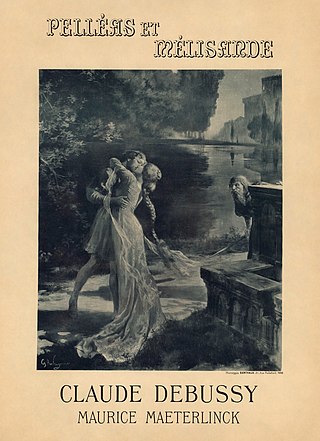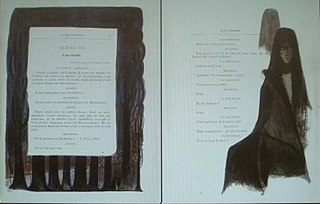
Jules-Jean-Paul Fort was a French poet associated with the Symbolist movement. At the age of 18, reacting against the Naturalistic theatre, Fort founded the Théâtre d'Art (1890–93). He also founded and edited the literary reviews Livre d'Art with Alfred Jarry and Vers et Prose (1905–14) with poet Guillaume Apollinaire, which published the work of Paul Valéry and other important Symbolist writers. Fort is notable for his enormous volume of poetry, having published more than thirty volumes of ballads and, according to Amy Lowell, for creating the polyphonic prose form in his 'Ballades francaises'.

Maurice Polydore Marie Bernard Maeterlinck, also known as Count/ComteMaeterlinck from 1932, was a Belgian playwright, poet, and essayist who was Flemish but wrote in French. He was awarded the Nobel Prize in Literature in 1911 "in appreciation of his many-sided literary activities, and especially of his dramatic works, which are distinguished by a wealth of imagination and by a poetic fancy, which reveals, sometimes in the guise of a fairy tale, a deep inspiration, while in a mysterious way they appeal to the readers' own feelings and stimulate their imaginations". The main themes in his work are death and the meaning of life. He was a leading member of La Jeune Belgique group, and his plays form an important part of the Symbolist movement. In later life, Maeterlinck faced credible accusations of plagiarism.

Pelléas et Mélisande is an opera in five acts with music by Claude Debussy. The French libretto was adapted from Maurice Maeterlinck's symbolist play of the same name. It premiered at the Salle Favart in Paris by the Opéra-Comique on 30 April 1902; Jean Périer was Pelléas and Mary Garden was Mélisande, conducted by André Messager, who was instrumental in getting the Opéra-Comique to stage the work. It is the only opera Debussy ever completed.

The Blue Bird is a 1908 play by Belgian playwright and poet Maurice Maeterlinck. It premiered on 30 September 1908 at Konstantin Stanislavski's Moscow Art Theatre, and was presented on Broadway in 1910. The play has been adapted for several films and a TV series. The French composer Albert Wolff wrote an opera based on Maeterlinck's original play, and Maeterlinck's inamorata Georgette Leblanc produced a novelization.

Charles Martin Tornov Loeffler was a German-born American violinist and composer.

Pelléas and Mélisande is a Symbolist play by the Belgian playwright and author Maurice Maeterlinck. The play is about the forbidden, doomed love of the title characters and was first performed in 1893.

Ariane et Barbe-bleue is an opera in three acts by Paul Dukas. The French libretto is adapted from the symbolist play of the same name by Maurice Maeterlinck, itself loosely based on the French literary tale La Barbe bleue by Charles Perrault.

Pelléas et Mélisande, Op. 80 is a suite derived from incidental music by Gabriel Fauré for Maurice Maeterlinck's play of the same name. He was the first of four leading composers to write music inspired by Maeterlinck's drama. Debussy, Schoenberg and Sibelius followed in the first decade of the 20th century.

Georgette Leblanc was a French operatic soprano, actress, author, and the sister of novelist Maurice Leblanc. She became particularly associated with the works of Jules Massenet and was an admired interpreter of the title role in Bizet's Carmen.

Intruder is a one-act play by Belgian playwright Maurice Maeterlinck, which appeared first in publication in 1890. Journalistic appreciations of the text throughout that year prompted Parisian independent theatre producers to get the performance rights. From its stage debut the following spring, it became identified as a landmark work in the Symbolism movement of the late-nineteenth century.

Princess Maleine is a play by Belgian playwright Maurice Maeterlinck. It was the author's first play. It is an adaptation of the Brothers Grimm's Maid Maleen.

Interior is an 1895 play in rhymed dialogue by Belgian playwright Maurice Maeterlinck. It was one of his few plays intended for marionettes.
Lawrance Arthur Collingwood CBE was an English conductor, composer and record producer.

Jean-Charles Nouguès was a French composer of operas.
Herbert Menges OBE was an English conductor and composer, who wrote incidental music to all of Shakespeare's plays.

The Théâtre de l'Œuvre is a Paris theatre on the Right Bank, located at 3, Cité Monthiers, entrance 55, rue de Clichy, in the 9° arrondissement. It is commonly conflated and confused with the late-nineteenth-century theater company named Théâtre de l'Œuvre, founded by actor-director-producer Aurélien Lugné-Poe, who would not take control of this performance space until 1919. His company is best known for its earlier phase of existence, before it acquired this theatre venue. From 1893 to 1899, in various Parisian theatres, Lugné-Poe premiered modernist plays by foreign dramatists, as well as new work by French Symbolists, most notoriously Alfred Jarry’s nihilistic farce Ubu Roi, which opened in 1896 at Nouveau-Théâtre.
L’Invisible is a 2017 opera by Aribert Reimann. The French libretto by Reimann is a condensation of three short plays by Maurice Maeterlinck; L'Intruse, Intérieur and La Mort de Tintagiles, into a single act opera. The "invisible" in each part is death, first as a supernatural force, then as tragic news, then in the person of a murderous queen.
Benjamin Attahir is a French composer, violinist and conductor. He studied at Conservatoire de Toulouse, at the Conservatoire à Rayonnement Régional de Paris under Édith Canat de Chizy and at the Conservatoire de Paris itself.
Harry Danks, (1912-2001) was a British violist and principal viola of the BBC Symphony Orchestra from 1946 to 1978. He was the founder and director of the London Consort of Viols.














